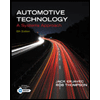
Automotive Technology: A Systems Approach (MindTap Course List)
6th Edition
ISBN: 9781133612315
Author: Jack Erjavec, Rob Thompson
Publisher: Cengage Learning
expand_more
expand_more
format_list_bulleted
Textbook Question
Chapter 21, Problem 10ASRQ
The yellow electronic throttle control warning lamp comes on occasionally while the vehicle is driven; Technician A says that this means there is a problem with the system. Technician B says that the system is actively regulating drive torque and engine power when the lamp is lit Who is correct?
- Technician A
Expert Solution & Answer
Trending nowThis is a popular solution!

Students have asked these similar questions
Technician A says the torque converter uses engine oil to provide a fluid link between engine and transmission. Technician B says the torque converter is attached to the engine crankshaft and receives the engine torque output. who is correct?
While discussing SFI systems: Technician A says that when the injection system fires according to crankshaft position and speed, it is operating in the synchronous mode. Technician B says that one of the advantages of SFI systems is that they are always in the synchronous mode. Who is correct?
An engine support fixture is used to hold the engine in place while removing a ______.
A. fwd transxle
B. rwd transmission
C. both
D . neither
Chapter 21 Solutions
Automotive Technology: A Systems Approach (MindTap Course List)
Ch. 21 - True or False? A driver information center...Ch. 21 - What is the purpose of an IVR?Ch. 21 - Explain how an air-core gauge works.Ch. 21 - What are two ways to provide input for the...Ch. 21 - Describe the two types of instrument panel...Ch. 21 - What is the device found in some fuel tanks to...Ch. 21 - What is the correct way to check a coolant...Ch. 21 - What type of sending unit is typically used to...Ch. 21 - What is the major difference between an indicator...Ch. 21 - True or False? The ABS lamp turns on whenever the...
Ch. 21 - The indicator needle on a speedometer is held to...Ch. 21 - Which of the following uses a permanent magnet and...Ch. 21 - What type of memory is used to store the...Ch. 21 - Which of the following is not a true statement...Ch. 21 - Which of the following statements about oil gauge...Ch. 21 - While discussing what the maintenance reminders...Ch. 21 - None of the engines gauges works: Technician A...Ch. 21 - The oil pressure light stays on whenever the...Ch. 21 - A digital speedometer constantly reads 0 mph:...Ch. 21 - All gauges operate but read lower than normal:...Ch. 21 - When testing an engine temperature sensor:...Ch. 21 - The coolant temperature gauge stays low (cold)...Ch. 21 - While discussing the instrumentation on a Toyota...Ch. 21 - The TPM warning lamp is lit: Technician A says...Ch. 21 - The yellow electronic throttle control warning...
Knowledge Booster
Learn more about
Need a deep-dive on the concept behind this application? Look no further. Learn more about this topic, mechanical-engineering and related others by exploring similar questions and additional content below.Similar questions
- Technician A says that if a drive belt does not have the proper tension, it may produce squealing and chirping noises. Technician B says belt tension should be checked even if the engine has an automatic belt tensioner. Who is correct? Technician A Technician B Both A and B Neither A nor Barrow_forwardTechnician A says that changes in engine load cause changes in hydraulic pressure inside the transmission. Technician B says that engine load is monitored by throttle pedal movement or by engine vacuum. Who is correct? a. Technician A only b. Technician B only c. Both A and B d. Neither A nor Barrow_forwardTrue or False? The ABS lamp turns on whenever the system is actively regulating drive torque and braking force.arrow_forward
- While diagnosing a cruise control system that does not turn on: Technician A checks the vehicle speed sensor and its input to the control module. Technician B checks the operation of the brake lights. Who is correct? Technician A Technician B Both A and B Neither A nor Barrow_forwardTechnician A says that some antitheft systems sound an alarm if someone enters the vehicle without a key Technician B says that some antitheft devices prevent the engine from starting. Who is correct? Technician A Technician B Both A and B Neither A nor Barrow_forwardWhich of the following would not cause noise while driving in 2WD under a heavy throttle? a. Faulty ignition switch b. Worn transfer case clutch c. Inoperative locking hubs d. Bad front half shaftarrow_forward
- A digital speedometer constantly reads 0 mph: Technician A says that the problem may be the vehicle speed sensor. Technician B says that the problem may be the throttle position sensor. Who is correct? Technician A Technician B Both A and B Neither A nor Barrow_forwardWhile checking the condition of a vehicles ATF: Technician A says that if the fluid has a burnt color or odor, the fluid has been overheated. Technician B says that a milky color indicates that engine coolant has been leaking into the transmissions cooler in the radiator. Who is correct? Technician A Technician B Both A and B Neither A nor Barrow_forwardTrue or False? To eliminate the drain of engine power during times when cooling fan operation is not needed, many of todays belt-driven fans have a fan clutch that prevents the operation of the fan when the engine and radiator are heated up.arrow_forward
- True or False? The neutral safety switch and reverse lamp switch are typically part of a digital transmission range sensor.arrow_forwardwhat is the purpose of having two accelerator pedal signals in an electronic throttle control systemarrow_forwardTechnician A says that throttle position is an important input in most electronic shift control systems. Technician B says that vehicle speed is an important input for most electronic shift control systems. Who is correct?arrow_forward
arrow_back_ios
SEE MORE QUESTIONS
arrow_forward_ios
Recommended textbooks for you
 Automotive Technology: A Systems Approach (MindTa...Mechanical EngineeringISBN:9781133612315Author:Jack Erjavec, Rob ThompsonPublisher:Cengage Learning
Automotive Technology: A Systems Approach (MindTa...Mechanical EngineeringISBN:9781133612315Author:Jack Erjavec, Rob ThompsonPublisher:Cengage Learning Automotive TechnologyMechanical EngineeringISBN:9781337794213Author:ERJAVEC, Jack.Publisher:Cengage,
Automotive TechnologyMechanical EngineeringISBN:9781337794213Author:ERJAVEC, Jack.Publisher:Cengage,

Automotive Technology: A Systems Approach (MindTa...
Mechanical Engineering
ISBN:9781133612315
Author:Jack Erjavec, Rob Thompson
Publisher:Cengage Learning

Automotive Technology
Mechanical Engineering
ISBN:9781337794213
Author:ERJAVEC, Jack.
Publisher:Cengage,
Mod-01 Lec-16 Basics of Instrumentation; Author: nptelhrd;https://www.youtube.com/watch?v=qbKnW42ZM5c;License: Standard YouTube License, CC-BY